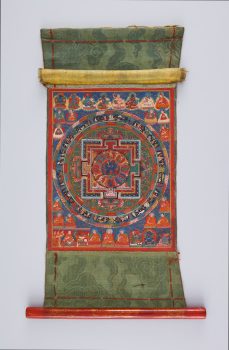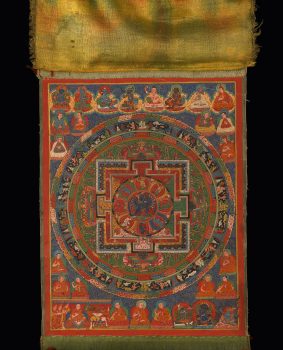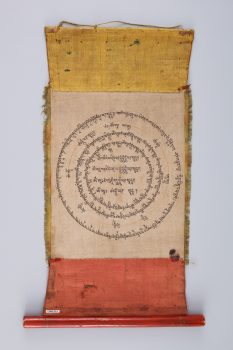Central Tibet
16th century




Central Tibet
16th century




This mandala of Hevajra is drawn according to the esoteric teachings of the great tantric master (mahasiddha) Virupa, an important teacher of practices in the Sakya tradition. Hevajra is a principal meditational deity of the secret tantric practice especially important in this tradition. At the center of this painting are Hevajra and his consort Nairatma, shown in union in their palace, which is depicted as a mandala, a floorplan-like geometric diagram. Eight goddesses, each in a lotus petal of a different color representing cardinal directions, surround the couple. Teachers of this specific practice sit on clouds at the top register while protector deities of the Sakya tradition occupy the bottom right corner. The back of the painting displays concentric circles composed of protective mantras and sacred syllables.
A religious movement that originated in India around the fifth to seventh century with sacred writings and esoteric teachings and practices transmitted from teacher to student through initiation. These remain an important part of Hinduism and Buddhism today.
A contemplative practice in which a person uses concentration and visualization to achieve aims such as transforming the mind and generating feelings of compassion. Techniques include focusing on breathing or visualizing oneself as a deity.
A meditation technique primarily used in tantric practice that involves imagining a deity in one’s mind or imagining oneself becoming a deity and carrying out various activities. Such techniques are intended to help a practitioner transform ordinary perception and achieve enlightened qualities.
A geometrically shaped tool used for meditation and visualization in Buddhist practice. It is a representation of the palace of a deity and the Buddhist conception of the cosmos.
Today, Tibetans primarily inhabit the Tibetan Plateau, situated between the Himalayan mountain range and the Indian subcontinent to the west, Chinese cultural regions to the east, and Mongolian cultural regions to the northeast. During the 7th to 9th century, Tibetan rulers expanded their empire across Central Asia, and established Buddhism as the state religion.
Get the latest news and stories from the Rubin, plus occasional information on how to support our work.